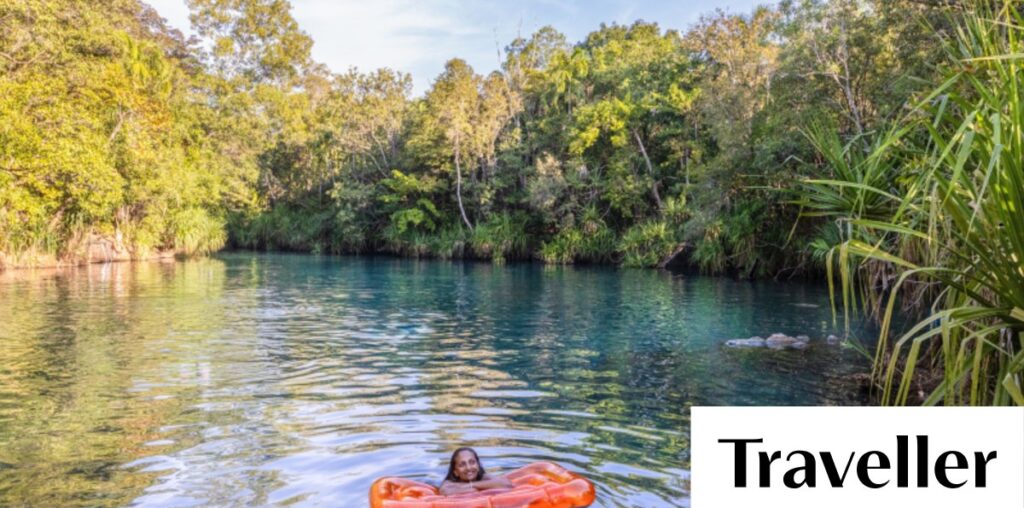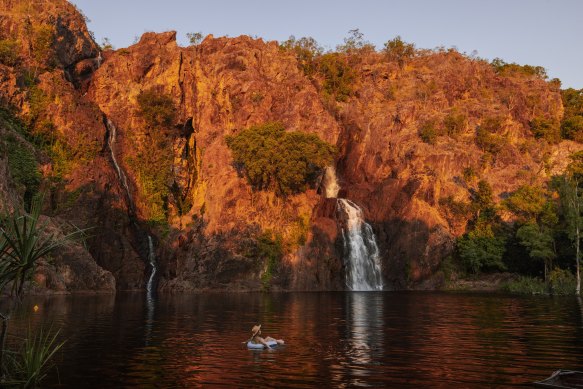
The anti-tourist tour … Ethical Adventures visit Litchfield attractions where the crowds aren’t, like Wangi Falls.Credit: Tourism NT
Woods’ company, Ethical Adventures, prefers to tailor the itinerary each day around where the crowds are not, rather than offer the standard list of Litchfield attractions to cross off, one-by-one.
“This isn’t Disneyland,” he says.
“I call ours the anti-tourist tour. But more operators are being vague these days, like we are, about what you’ll see. Isn’t that the fun of it?”
For such dry, escarpment country, Litchfield National Park is filled with water. You’ll find some of the country’s most spectacular waterfalls side-by-side, all accessible via paved roads. Above and below each waterfall, water flows into crystal-clear pools, between spectacular sandstone pillars, like some sort of real-life theme park.
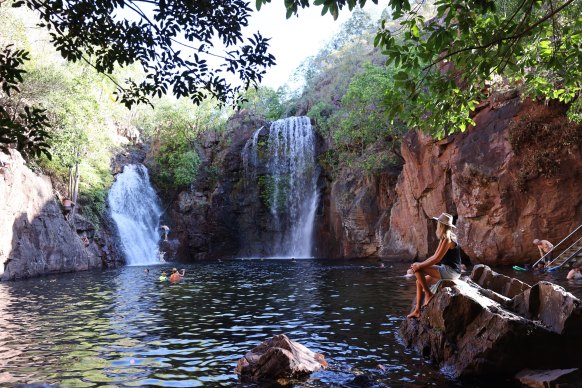
Florence Falls … find some of the country’s most spectacular waterfalls side-by-side at Litchfield National Park.
Woods navigates his way through the circuit delicately, reversing out of car parks at the hint of a crowd.
“Hang on, big group of backpackers, let’s go,” he announces through a cloud of dust. We stop instead at a seasonal billabong set in a paperbark forest (Tabletop Swamp), a refuge for birdlife. “Walk out there,” he orders. “Sit down, watch the birds fly among the trees, breathe it in.”
We find empty swimming holes among the waterfalls, and swim in the cool, croc-free water, sliding down cascades between pools, over rocks silky-smooth from millions of years of water flow. It’s late afternoon when Woods finally gets me to the park’s most spectacular waterfall.
Tolmer Falls cascade over two high escarpments into one huge plunge pool, 102 metres below. The swift passage of water against sheer sandstone cliff creates a huge rainbow against the apricot haze of the sunset trail. It’s as delicate a scene as you’ll see in such a rugged part of the country.
Four hours west from here, Kakadu National Park is another of the Northern Territory’s world-famous national parks which can smother itself in its own popularity come the dry season. A bucket-list attraction too often ticked off on a fast-and-furious coach tour out of Darwin, new Indigenous operators are encouraging visitors to slow down and see Kakadu differently, with a smaller carbon footprint.
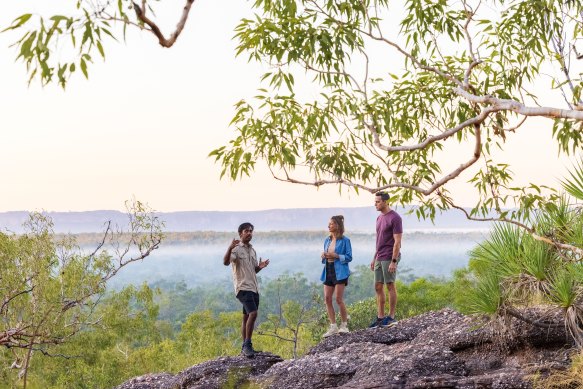
Yibekka Kakadu Tours operates private or small group 4WD tours that take visitors deep into his country.Credit: Tourism NT
Like 27-year-old Bininj man, James Morgan, who named his tour company: Yibekka Kakadu Tours, which translates to “listen and feel Kakadu”. Coach loads of visitors pass by on their way to must-visit sites, obvious from the size of the car park adjacent, but Morgan’s private or small group 4WD tours instead take visitors deep into his country.
“These tours are one of the only ways we can present our real cultural heritage,” he says. “Tourism is huge here, but most tour guides are non-Indigenous. I felt like it was a huge missed opportunity for the local Binnij people. I wanted to provide more job opportunities.”
We walk through the wilderness while Morgan shares stories handed down across generations of his ancestors. I’m surrounded by huge sandstone escarpments, in a 1.2-billion-year-old landscape that predates fossils.
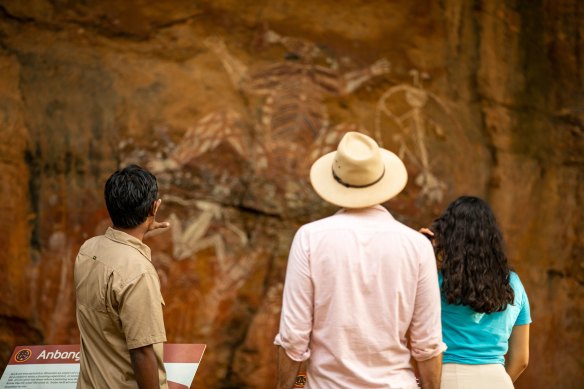
Nourlangie rock art … there are over 5000 instances of rock art in the park.
Though it’s the dry season, a storm brews on the horizon. “My uncle says you should never look at lightning,” he says. “It’s a powerful spirit. And watch out for the mimi spirits (paintings of the spirits date back 50,000 years in Kakadu), they live in rocks and shelters. If you’re walking by yourself, they’ll come out and grab you. Even all the rangers here won’t do that, especially at nighttime, you couldn’t pay them enough to be here alone at nighttime.”
As I walk with Morgan he explains the nuances of his land: the woolly butt trees flowering red at the start of winter, the citrus stench of eucalypts on a hot day, the nutty smell of pandanus that makes me think of Christmas.
A visit to Kakadu, he says, isn’t about where you go, it’s about the passage back through time you take – among the spirits of a thousand generations of the world’s oldest living culture. There are rock art sites (over 5000 in the park) down near the big carpark where visitors gather on paved walking trails beside information plaques, but the presence of Morgan’s people reaches out far beyond the obvious.
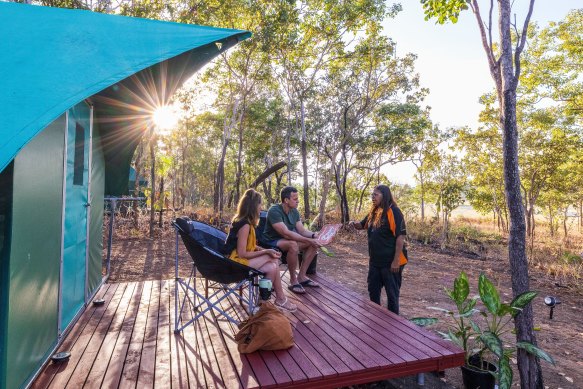
Traditional owner Mandy Muir helps glampers connect with Murumburr Clan country at Kakadu Billabong Safari Camp.
Morgan drops me near Kakadu Billabong Safari Camp, a new 100 per cent Aboriginal-owned and operated family business in the heart of the national park. Local traditional owner Mandy Muir leads me into the Murdudjurl Patonga Homestead Community where she lives, an Indigenous settlement built on the edge of a creek with water as blue as the ocean.
We walk through the wetlands, mindful of crocs, and watch Muir’s son-in-law catch a barramundi. Back at the homestead he cooks it on the coals of an earth oven, and we eat it with her family under the shade of a red gum.
Muir operates glamping tents on an outcrop overlooking a billabong a few kilometres further up a dirt road. There’s an exclusive kind of luxury I feel out here, surrounded by nothing but woodland and wetland and mimi spirits. There are hot water showers, courtesy of today’s blaring sun, and a meal I eat outside in the twilight, watching wallabies hop down slowly to drink at the billabong, also mindful of hungry crocs.
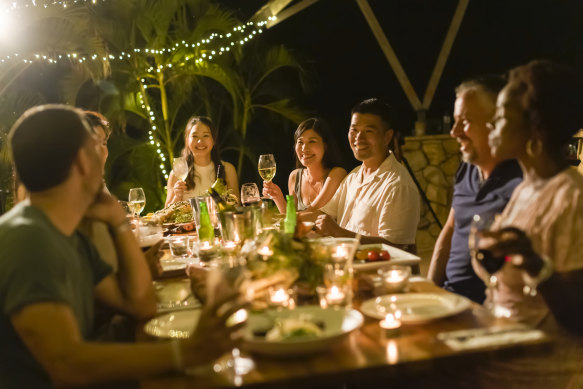
Dining under the stars … Cooinda Lodge, Kakadu’s oldest lodge.
Even at Kakadu’s most established tourism epicentres, there’s an emerging shift towards cultural and environmental sustainability. At Kakadu’s oldest lodge, Cooinda Lodge, I arrive in time for the Kakadu Dird (full) Moon Feast served out under the stars, a monthly collaboration between local indigenous chef Ben Tyler and executive chef, Phil Foote.
Ingredients are foraged on country, prepared using traditional methods and served across four slow courses. I eat everything from popcorn crocodile to barramundi smoked in paperbark leaves, to wild buffalo, cooked in coals for 12 hours within a ground oven.
“There’s so much Indigenous food the world’s never even tried,” local Indigenous chef, Krystal Dalton, tells me as I eat.
“We serve you something you can’t get anywhere else in the world. I reckon that’s what Kakadu and the Northern Territory should be about.”
The details
Fly
